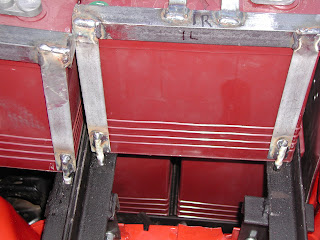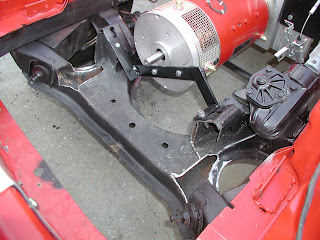Here is how (for next to nothing) you can supply a proper square wave pulse to a tachometer that will then read the RPM of your electric motor.It's still a bit chilly outside this morning so I thought I would play with this issue until it warms up enough to go out and work on the car. I have a digital tach in my existing dash and I have intended from the start of this project to use it for the electric motor. It is advantageous to know the RPM of the motor because there is a certain range (around 4000 for mine) that it is most efficient. Knowing what the RPM is at any given speed will allow me to be in the most appropriate gear to get the best performance from my motor and longest life out of my batteries.
These common motors and controllers like I am using have no output for a tach. For months I have been researching on-line about how to make a tach work. I have read about some ingenious and complicated ways that other people have done it - most of which I didn't really understand or was not capable of doing. I have not found one straight forward description that was easy, inexpensive, and sure to work for my setup. So, here is what I did. This should work for any remotely similar setup using a stock automotive tachometer. Maybe this information will fill a void and help someone else.
I had an old 70's type distributor with electronic ignition which I disassembled.

I salvaged what amounts to a 'magnetic gear tooth sensor'. The collar with the ridges on it rotates with the distributor. Every time a ridge passes the sensor magnet, a small pulse of electricity is generated.

I just happen to have a spare digital tach that I have never used. This is good for a test instrument so I hooked it up to a converter and powered it up with 12 volts.

The green wire on this, and most tachs that I have seen, is the sensor input. I tried various ways to get the tach sensor to recognize the little electrical pulses produced by the sensor but it wouldn't. So I went back out to my giant stash-o-parts and found an old 70s ECU (Electronic Control Unit). This is what the gear-tooth sensor originally plugged into.

I plugged the distributor into the mating plug. I then hooked the 12 volt power (positive) to the wire that originally went to the plus side of the coil. Then I hooked the ground (12v negative) to the metal case of the ECU. Lastly, I connected the wire that originally went to the negative side of the coil to the tachometer sensor input (green) wire. As I passed the metal collar past the magnet, the tach registered pulses.

Just to be sure, I affixed the collar to a cordless drill and rotated it at various speeds next to the magnet. The tach registered various RPMs. I did not take a picture of that because I only have two hands:) You'll just have to take my word for it.
So that's where I am today on solving this problem. The next step will be to modify it a bit to make it work for this application. The metal collar will be mounted to the tail shaft of my motor (the small shaft at the front) and will spin with the shaft.
The collar has 8 ridges on it. This means that the sensor generates 8 pulses for every revolution of the old distributor. A distributor rotates once for every two crankshaft rotations in a 4 stroke engine. So by my advanced math calculations, I figure 4 pulses of the sensor will equal one electric motor shaft revolution. Solution: grind down every other ridge so only four pass the magnetic sensor per revolution.
The last piece of the puzzle will be to mount the magnetic portion of the sensor to a stable surface where it can be adjusted close enough to the gear to sense the passing ridges.
Beautiful in it's simplicity! Best of all, it didn't cost me anything. However, these should be common, inexpensive junkyard parts if needed to be purchased.
I'll post the 'final chapter' to this when I finish the installation in the car sometime soon.

















































